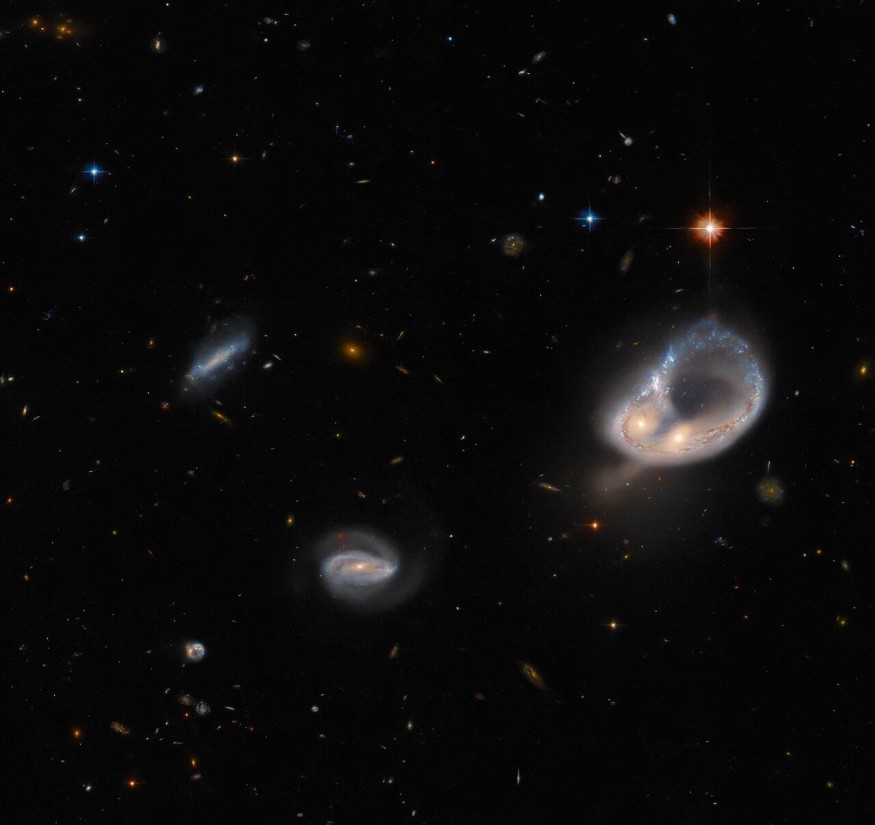The Hubble Space Telescope captured a stunning shot of a glowing ring of stars formed after a pair of galaxies in the constellation Eridanus had been warped and twisted. The intense gravitational forces between the two galaxies resulted in the chaotic merger.
According to Live Science, the entwined galaxies are collectively known as Arp-Madore 417-391. The galaxies are located around 670 million light-years from Earth in a constellation visible from the Southern Hemisphere.

Ring of Stars in the Peculiar Galaxies
The Advanced Camera captured the new image for Surveys (ACS) onboard the Hubble Space Telescope to observe Arp-Madore 417-391, also known as AM 417-391. The ACS instrument is optimized for hunting galaxies and galaxy clusters.
Moreover, the camera has contributed to astronomy scientific discoveries for 20 years. Throughout its lifetime, ACS has been involved in mapping dark matter distribution and galaxy clusters' evolution.
The European Space Agency (ESA) posted the photo on November 21, 2022, in which they explained that the interacting galaxies have been distorted by gravity and twisted into a ring of stars, leaving the cores of the two galaxies side-by-side.
Hubble astronomers explained that the Arp-Madore catalog is a collection of peculiar galaxies spread throughout the southern sky. The catalog includes a collection of subtly interacting galaxies and spectacular colliding galaxies in the universe.
The colored image of the entwined galaxies was made from separate exposures taken from the visible and infrared regions of the spectrum, according to Sci-News. Astronomers used four filters to sample various wavelengths, resulting in colored images from different hues.
They added that the image is from a selection of Hubble observations designed to create a list of intriguing targets for follow-up observations for the James Webb Space Telescope and other ground-based telescopes.
Astronomers chose a list of unobserved galaxies for the Hubble to inspect between other observations of the galaxy. Over time, it helps them build up a collection of interesting galaxies. Apart from the ACS, the new image also contains observations from the Dark Energy Camera (DECam) on the Víctor M. Blanco 4-m telescope located at Cerro Tololo Inter-American Observatory.
Ring Structures in Interacting Galaxies are Rare
NASA said that ring structures in galaxy mergers are extremely rare as they only form when colliding galaxies smash into one another head-on rather than slowly getting pulled to each other.
Furthermore, ring structures are temporary and last for only 100 million years. After that period, the stars are gradually pulled back into their parent galaxies and eventually merge into a single galaxy in 1 or 2 billion years.
To date, astronomers have identified 100 ring structures in galaxy mergers, although only a few have a perfect circle, like Arp-Madore 417-391. The entwined galaxies have an asymmetrical shape likely due to their roughly the same size, hinting at the roughly similar size and brightness of the two galactic centers.
However, scientists are unsure how the ring was formed. ESA said that the JWST might also investigate the galaxies as they have been flagged as potential targets.
RELATED ARTICLE: Hubble Space Telescope Inspects Two of the Galaxies in a Galactic Triplet 200 Million Light-Years Away
Check out more news and information on Space in Science Times.










